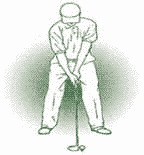Golf Tips2
Getting Up and Down from a Greenside Bunker
One of the most common mistakes that most golfers make while playing a bunker shot is that they shift their weight to their back foot when taking the club back.
When you are in a bunker�or chipping from around the green, for that matter�make sure that the majority of your weight is on your front foot at address. Keep it there throughout the swing.
If you shift your weight to your back foot in a short abbreviated swing such as a chip or bunker shot, it will be very difficult to get your weight back to the ball. If you leave your weight on your back foot while playing a bunker shot, you�ll hit the shot much �heavier� than you�d like, and you�ll likely leave the ball in the bunker.
Good balance is key
1. Begin by placing your feet together. Take some short swings, letting your body turn as the club swings freely back and forth. Keep your feet together and lengthen your swing until you reach your full back swing. Hit a few shots, keeping your feet together.
2. Now, move your feet until the heels are about shoulder width apart. Make short swings, expanding again to a full swing. You will begin to feel the balance. Notice your weight moving naturally to the right and left and back again. Hit a few more shots, letting your arms swing and weight move naturally back and forth.
3. Your follow through is as important as your starting position or top of your back swing. You should have good balance in all three positions. Imagine how you would want to look if someone was taking your picture at the end of your swing. You would want to look like the pros on TV...weight on your left (for right-handed golfers), belt buckle facing the target, club over your left shoulder.
4. Assume that position. Feel it. Now do it -- swinging the club to a full backswing and through to that great finish. There you have it � you�ve just completed a balanced golf swing!
Proper Grip
Nobody believed in fundamentals more than Hogan. His entire life was a search for the fundamentals. He dug them out of the dirt & tested them on the practice range & then put them to the crucible at the world class level & and he saw them work.
With respect to the hands, he says simply: "Good golf begins with a good grip."
The operative word here is "begins." Every golfer out there starts from the same gate: and the key to unlocking the gate and going forward is a fundamentally sound grip.
When the hands are placed properly on the club, they can work as a unit. When the hands work as a unit, they are able to make an important contribution to speed, consistency and control through impact.
Who doesn't want speed, consistency and control through impact?
The Left Hand Grip
Hogan favored more of a palm grip in the left hand. In the palm, he believed, you had more control than if the club was in the fingers of the left hand.
Lie the golf club across the left hand so that it runs diagonally from the heel pad to the first joint of the index finger.
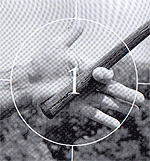
This is one of golf's great instruction photographs taken by Tony Ravielli. Download it and place it on your refrigerator door. Etch it into your mind for it is the very first step becoming a real ball striker.
Left hand Pressure Points
Pressure at the correct points mean, once again, speed, control and consistency. In the left hand grip, pressure comes "up" from the last three fingers of the left hand and "down" from the palm pad. This helps keep the club from coming loose through impact.
When Hogan looked down at his completed left hand grip, the "V" between his thumb and forefinger pointed towards his right eye.
Right Hand Grip
While the left hand is palm oriented, the right hand is finger oriented. Specifically, the club should be placed across the top joints of the fingers, just below the palm.
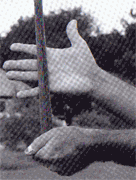
Right Hand Pressure Points
The right hand pressure points are the two middle fingers of the right hand. In addition, pressure comes from the knuckle above the right index finger.
To further link the hands, Hogan used the "Vardon" grip. If you were to attribute qualities to Hogan's grip, you might say:
-secure
-comfortable
-alive tension free
Leadbetter's Point of View
Realize that Hogan fought a devastating hook for most of his early career. By devastating, we're talking low and hard left-to-left. Here's what he said:
"I hate a hook. It nauseates me. I could vomit when I see one."
So, Hogan built an anti-hook grip. Problem is most golfers don't hook, they slice.
Realize, too, that Hogan was an exceptional athlete who had strong, fast hands & and an amazing flexibility in his wrist/thumb area. 99% of the amateurs I teach don't have that strength or flexibility.
Hence, I teach a "stronger" grip. The left hand is turned to the right and two or three knuckles are visible to the golfer.
The Leadbetter Slice Cure
A palmish grip tends to "freeze" the wrist action which is exactly what Hogan wanted. But for the average golfer, frozen wrists spell a feeling of a lack of power. What happens? The amateur tries to force some motion into the swing. Tension is created. The golf club slows & and is moved off line.
A solution is available. Let me give you a brief overview positioning the left hand properly.
The golfer feels that the club is in balance and that little, if any, effort is required to produce power and "snap" in the swing.
 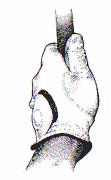
Now look at:
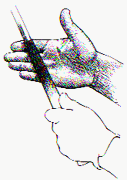 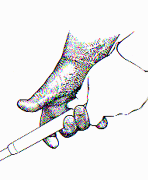
That's probably right for you (unless you hit low, left-to-left "snipes.")
Remember. "Good golf begins with a good grip." Lets get a good grip and good understanding.
Your task for the coming week? Practice your grip. Don't worry about hitting balls. Don't even worry about practice swings. Just spend time carefully placing your hands on the club, modeling the pictures we have given you.
Back( Golf Tips)
|


